Dave Johnson's Blog
January 3, 2021
Save The Cat!
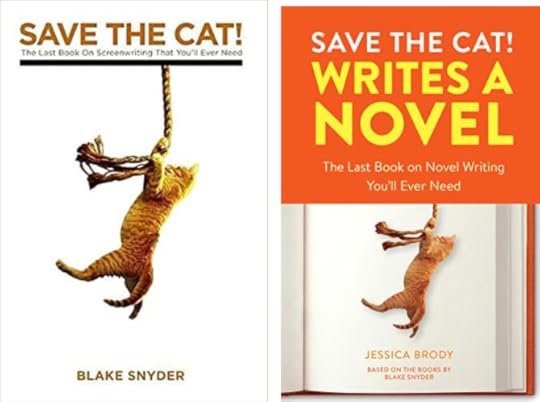
I came across a post on Instagram during the summer of 2020 and it asked the question "Are you a Plotter or a Pantser?" I had absolutely no idea what this meant! Then in the same post I saw a reference to "Save the Cat." I had never heard of that either, so I googled.
I discovered that it related to a book written by a Hollywood screenwriter, Blake Snyder, in 2005 who had analysed the plots of successful films and broken them down to fifteen plot points, or beats as he called them. It caught on, and soon lots of screenwriters were using his guidelines.
Why 'Save the Cat'? Well, a key thing is that the hero of the story, apart from having a goal they want to achieve will also be flawed. But, if you have an unlikeable character, you then make them rescue a cat from a dangerous situation (doesn't always have to be a cat) and then the audience will be rooting for them.
I won't detail all the plot 'beats' here, it's easy enough for you to find them on the internet, but some notable ones are 'Bad Guys Close In' in the middle of the film, followed by 'Dark Night of the Soul, and then 'Gathering the Troops', as you get ready for the finale.
Unfortunately, Blake Snyder died unexpectedly in 2009. In 2018 Jessica Brody adapted the book to make it relevant to novel writers, and she applied the formula to many successful novels, from Jane Austin's 'Emma' to 'Me before You' by Jojo Moyes. So, I bought this book and thought 'Interesting.' By then I had already written Stuck (in time) and Stuck (1595) An Elizabethan Adventure. So I decided that when I wrote the next book in the 'Stuck' series I would give it a go!
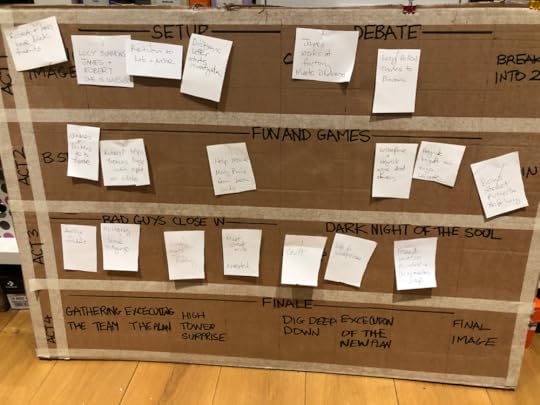
I realised that I had been somewhere between a Plotter and a Pantser - A Plotter works out the plot beforehand, a Pantser writes by the seat of their pants- making it up as they go along. I only had a loose idea where the story was going. Enough of an idea that in the last book I could write whole sections out of order, but when I set out, I had little idea of where I would end up.
So that's where I am now - I am trying to plot the story out, and have made a large cardboard chart, to which I pin notes that will each be developed into a scene. It's actually very useful as I know less about the period that the book will be set in, 1824, than I did about the previous two books (WWII & the Elizabethan age), so it means that the background research I am doing at the moment has a direction.
What's that I hear? 'Meow'? - I must go and investigate.
November 18, 2020
And the winner is.....
Rachel Laurence and I have been recording the new audiobook. Wait! Maybe I need to go back a stage. During the first UK lockdown, before we had even finished the audiobook for the first book Stuck (in time), I started writing a follow-up book. It's finished…ish, but not published yet. The reason it's not published is because we change it slightly as we go along - sometimes words are swapped around to make it read more smoothly or to make the meaning clearer. Rachel has contributed a couple of funny 'one-liners' too.
As I write, still to do is the 'Introduction' - and for that I need to finalise the title of the book. It's had a working title ever since I wrote it, and I wasn't sure if it was the best one, so I emailed a few close friends with a few suggestions. I mocked-up the titles using some sections of prints produced by Elizabeth Newsham, who designed the first cover (this won't be the actual cover design).
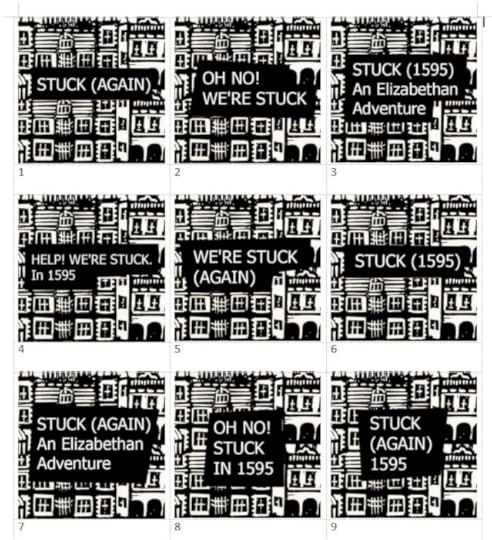
As you can imagine, they selected quite a range of different choices. But after reading some of their comments, and looking at the screen for quite a while trying to visualise the finished book I have decided to go with this one:
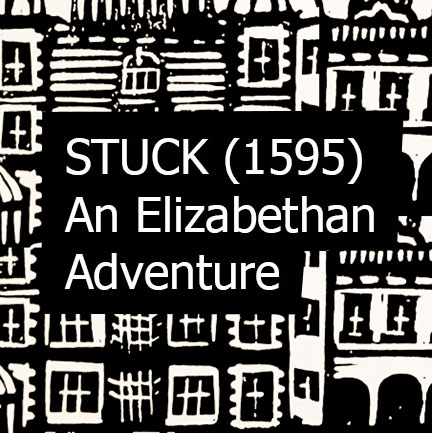
October 2, 2020
Where am I?
The sun loungers have been put in the garage, the leaves are turning brown, there's a cold wind blowing in from the North, and more parts of the UK are going back into Lock-down to shelter against Coronavirus. It's a time of change.
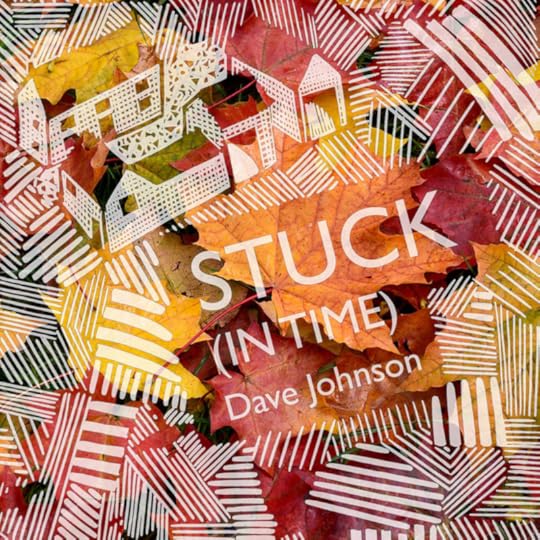
Illustration adapted from Elizabeth Newsham's design for the Audiobook cover
As I haven't posted for a while I'll sum up what's been happening. I spent the end of last winter, recording the audiobook with Rachel Laurence. With the Spring came Lock-down, so I spent a lot of that time writing the follow-up book to Stuck (in time) - this time the children travel back to Elizabethan times. During this time the book was published by Amazon for Kindle/Ereaders. After time spent reformatting the book, I also published it in a paperback version. Once Coronavirus restrictions had eased we were able to finish the audiobook. There was then a three month wait whilst it was undergoing technical tests, only to fail - not because of sound quality issues, but because I had included a dedication in the 'Opening credits' file. That was easily sorted out and after another couple of weeks it too was available for sale.
Job done! Well, no not really. Unless people buy the book it won't rise up the charts, so no-one will know it exists, and if they have never heard of it, they can't buy it. Catch 22 (now there's a snappy title for a book). For that reason I have spent the last few months trying to promote the book on Instagram - trying to reach out to the legions of book lovers on the site, (they call themselves bookstagrammers), and get them talking about the book. It takes lots and lots of time!
I have approached bookstagrammers to ask if they would like to review my book and I am pleased to report that several have done so - you can find the results on the reviews section of my website. I've also discovered that there are reviews and there are reviews! All some reviewers do is give a version of a blurb - they tell you what the book is about, they say they love it, but they don't really analyse why. Still, they may have lots of followers, and some of them may buy the book, whereas if they hadn't seen that review they would never have heard of it.
I much prefer the reviews that have a critical reaction to my book - all so far have been positive, but some may point out something that niggles them. I am quite happy to publish their reviews in full - whilst the very act of having a blog, or a website is to some extent a promotional exercise, I do not want to cherry-pick the choicest phrases and turn the reviews into adverts. Sometimes I disagree, sometimes they have a point, and its my job to reflect on these and make sure they are addressed in the next book.
I suppose it's a little like buying music. You might have your favourite artists and when you hear a new album is coming out you might even buy it without listening to it. That's especially was how it was when I was a teenager/young adult. But how many times do you have to hear a song on the radio by a new artist before you decide to buy it?
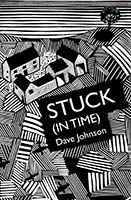
So that's where I am now - humming my song into the internet. The next post will probably be about what's next - finishing the follow up book and get ready to start recording a new audiobook.
July 23, 2020
Instagram - more tips and observations.
This post is mainly aimed at those people who use Instagram to promote a business or a product. Whether it is a painting, a piece of furniture, or in my case a book, it's all relevant
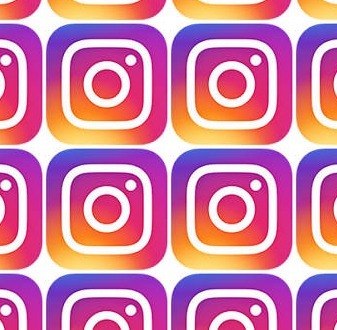
You are not using Instagram to sell the product itself, you are using it to publicise the product and then lead them to where they can buy it.
Your bio is the information displayed above your grid. It's easy to change in settings. A few things to note - the name of the account, and the name above your description are both searchable - you should consider if you can make them different - so people could find me searching for 'stuckdave', or for Dave Johnson.
You can only display 150 characters on your bio, so use them wisely - can visitors understand what you do?
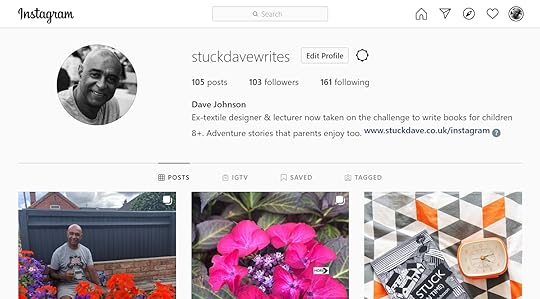
You only get one clickable link on your bio - some just put on a website, but there may be a better option. Your link could point to a page that gives several options - where do you want visitors to go.
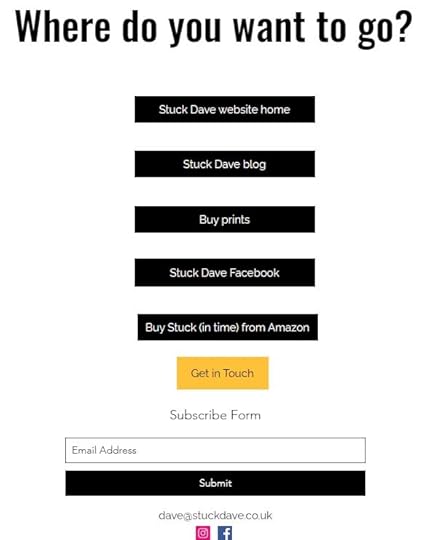
To make a page like this you can use sites such as Linktree (there are alternatives but Linktree seems to be very popular.)
Or, if like me, you create your own web pages, you make a page which has a number of buttons (rectangles that link to other web pages) see above. You make it so this page is not visible on your websites navigation bar (on wix there is a symbol of a crossed out 'eye' to hide this page.) So on mine, I have included my website & Facebook page, but more importantly a link to the Amazon page where you can buy the book.
If you are using Instagram to promote a business or a product you should switch to a business account - you can do this without losing all your previous posts and it doesn't cost anything. It's straightforward to do - you head to 'settings' on your profile. One of the big advantages to this is you then have a 'view insights' tab under your posts - so you can see how that post has performed. Not only that, you can go to your profile page, and there is another 'insights' button where you can see how all of your posts have performed, arranged in a grid, showing which posts had the most likes/follows/comments/etc.
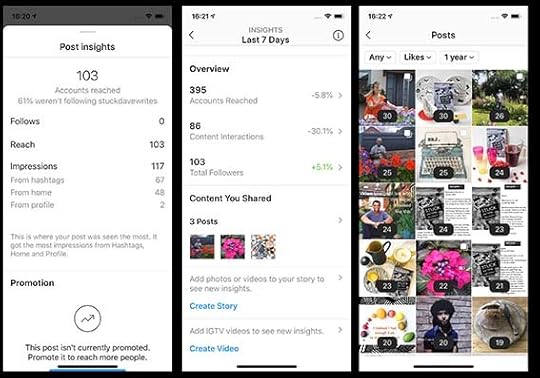
From Insights you can see the reach of a post, ie how many people could have seen the post, and also impressions - how many looked at it. Impressions are usually higher, because some people will look at the same post more than once. You can see how many are followers, and how many found you through hash tags. All this, and more, might help you determine a strategy. - what works, what doesn't work. To remind you of the main topic in my previous blog post, 'likes' are not enough - you need to know your posts are getting out to people (your reach) and the more people that make comments, and the more you respond, the wider the impact of your posts will be.
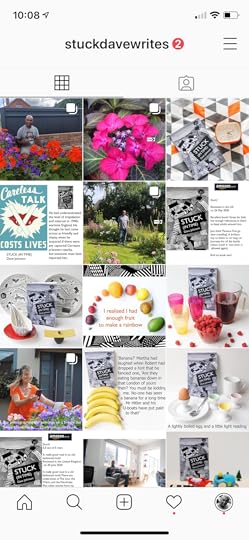
I have learned that how you design your grid is important, especially for anyone who isn't following you, and comes across you, perhaps from a hash tag. On the one hand there needs to be a consistency, say in the way you photograph your subject matter, but there also needs to be variation, so the images don't all blur into one. So an abstract painter for example would try not to have two similar paintings next to each other but would intersperse them with shots say, of brushes in a pot, or themselves working in the studio.
Sometimes it is worth posting a photo that doesn't sell a product, and won't necessarily get the number of 'likes' as other posts, but if it makes the grid interesting as a whole, then it can keep a visitor on your pages. It's good to have some shots showing you doing what you do. People are interested in people.
I hope these observations are useful. I'm writing very much from the point of being a beginner, wanting to share experiences, not as any kind of expert!
July 3, 2020
Instagram - I was an absolute beginner but now I know this!
I've been doing research on Instagram and I thought I would share some of what I've learned over the last couple of weeks. You may know all of this, but if not, it may be worth keeping in mind, so you can gain more followers, and have your posts seen by more people. I'm going to split it into 2 blog posts.
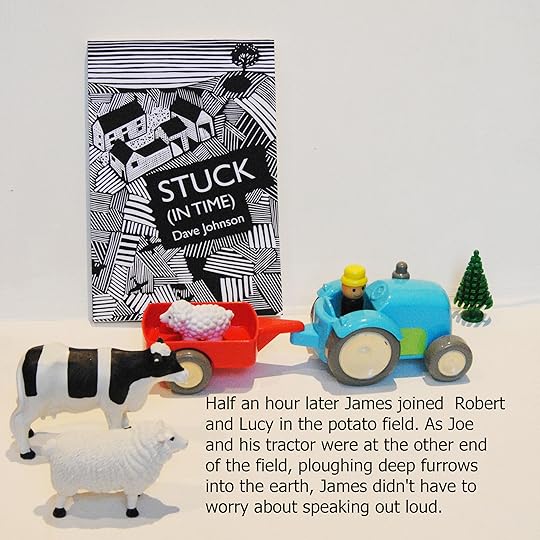
(Left) One of my Instagram posts.
A key thing is to know that it is not enough to just 'like' people's post - you have to comment.
In case you are new to Instagram (I was, only a few weeks ago) these are some basics (otherwise skip this bit - important stuff further on) - Instagram is a place where you can post photos & videos, and make/receive comments on them. It's designed to be used on a phone, but you can look, and comment on a computer, you just can't post photographs from it.
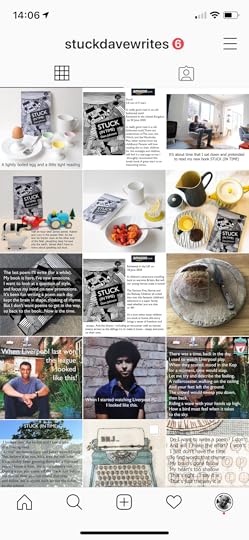
(left) My grid
There are five main parts to it - your 'Feed'. This is where you see recent posts from people you are following, or who are using a hashtag you are following. You usually see one image at a time and scroll down to see the next one.
Your 'Grid': this is where all your posts are arranged in squares, three squares per line.
Your 'Activity,' where people who have liked and/or commented on your posts are listed, together with those who have started following you.
A search facility, to look for people or hash tags
A direct message section - so you can send private messages.
Another option you have is to post a 'story' - a short video clip (up to 15 seconds) or a photo which only stays visible for 24 hours. Often a 'fun' post.
Now for the important stuff
Instagram started as a time-based platform - you posted something, and all the people who followed you saw it, for a while, until it slipped down the list of posts on your feed, replaced with newer posts. Now it is different, Instagram has an algorithm which means that only 5 or 6% of your posts may pop up on your followers feeds. The algorithm is looking for signs of activity and only sends out your posts if it feels they are coming from a healthy account. It's not a bad thing if you know how to use it - Instagram has grown so much that if it were the old system now, your posts would quickly get lost.
So what is it looking for? It's calculating how many people have reacted to your posts, and how long have they spent looking at it/responding to it. So it needs more than a quick 'like' on your post. It is looking at a combination of factors. It doesn't matter what anyone says in a comment, it's looking at quantity, not quality. It also needs responses to happen soon after your image is posted. That's why so many Instagram people ask questions on their posts. Our daughters have been quite useful, I've primed them to make comments, and then I will always make a comment about their comment. (usually old pictures of me generate comments!). Sue and I comment on our posts too (even if we are sitting side by side!). Facebook comments don't work like this by the way.
Another thing related to this, and I know I have been doing this, is that when you are trawling through looking for interesting people, if a post has lots of comments on it, you are more likely to click on it - so it helps the algorithm, and also you might gain new followers.
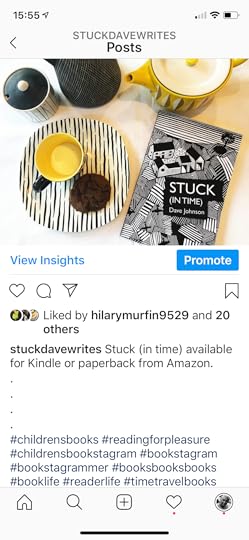
Captions and Hashtags
When you post a photo you write a 'caption.' This is intended to tell the viewer what they are looking at, and hopefully draw them in to making a comment, but you need to ensure the important stuff happens within the first three lines, or the viewer may not click 'more' to read the rest of it.
You can add hashtags here (what is a hash tag? I'll explain below), or you can put them in your first 'comments' box - if doing the latter, do so as soon as you have posted. I've tried both methods and I favour putting them in the first comments box. Two reasons - I now have my Instagram account set up to automatically post onto my business Facebook page when I add anything new. If they are in the first comments box they don't clutter up the Facebook page with meaningless hash tags. Secondly, whilst you can't put the initial photo on Instagram from a laptop, you can add comments from it. So, I find it's better to have all the hashtags saved in a Word document on my laptop, and I will copy and paste them into Instagram straight after posting the image using my phone. If putting hashtags in with your caption, it's common to have 5 dots on each line first (as in example in the image) but there is no need to do this if you are putting them in your first 'comments' box.
Hashtags: it's a means by which people find others who are interested in the same thing, so if I search for #dave for example, as I write, there are 872,896 posts where people have used this hashtag in their post. If I were 'following' this hashtag, anytime anyone used it, it may pop up in my feed. So a few words of advice:
Use relevant hashtags to you, for example, I may use #timetravelbooks (which has 2,303 posts, not many in Instagram terms, but I can see my posts showing up in the
Don't use the same hashtags everytime. Instagram is looking for evidence that you are a real person - if it suspects you are computer generated (a bot), because you use the same hash tags, or the same comments, it may prevent your posts being visible.
Don't just go for the most popular hashtags. Many have over a million posts - #love has 1,849,133,375 posts - no-one is likely to find you if you are swallowed up in that lot. 200,000 - 300,000 max.
More about Instagram on the next blog post.
June 18, 2020
Coffee time
Why am I writing about coffee? I don't drink a lot, usually two or three small cups a day. I always have tea for breakfast, unless I'm on a plane, where the tea is usually horrible. There again, so is the coffee! I often write during the morning, and by 10.30 I need refueling, with coffee, in order to keep going.
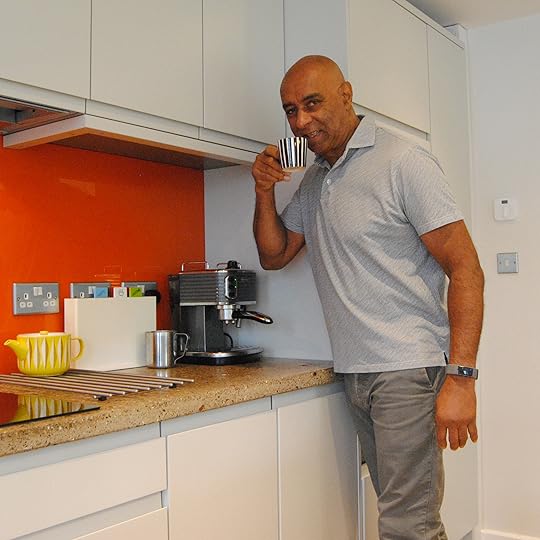
When I was young there was a coffee we used to drink called Camp Coffee. It was liquid, in a bottle that looked more like a sauce bottle and was coffee combined with chicory. I'm sure I wouldn't like it now. l haven't seen it for years and just googled it to see if it is still in production, which it is. It was reputedly created so that soldiers, serving in India in the days of the British Empire could have an instant coffee, rather than grinding coffee beans. What is interesting though, in the light of the current #blacklivesmatter is what happened to the label over the years. The first labels showed a Sikh man, holding a tray, serving a seated Scottish soldier. Later they removed the tray, so he was just standing rather stiffly by the side of the sitting soldier, but by 2006 they allowed the Sikh to sit down, next to the Scotsman, and even gave him a cup of coffee to drink, so he has graduated from being a servant to a fellow soldier.
The first time I went to America, in the 1980s, you were still talking about the days when in a British cafe, coffee was spooned out of an instant coffee catering tin, the size of a drum. It was such a novelty to be in an American diner or cafe, where you were offered instant refills from a waiter or waitress circulating with a jug of coffee. After a few visits I realised that I didn't really like the taste of the coffee, a combination of being weak, with a slightly burnt taste. Maybe it has improved now, I haven't been to the USA for a while.
Much better was the taste of coffee in Italy. I can remember, on a trip to Florence, where we taking students from Loughborough College of Art and design on a drawing trip, the frequent stops at a cafes for a coffee to give us a boost as we explored the city. In contrast to our American experiences coffee was a small shot of espresso, and like all good Italians, was drunk standing up. On another drawing trip, this time in Spain, I remember the coffee was enlived with a small shot of alcohol. My mother likes a shot of brandy in her coffee - so did her mother too. I'm fond of it too myself but we rarely have any brandy in the house - if we did I would drink too much coffee!
June 10, 2020
Shall I do this?
My second book is waiting for me to do all the edits & corrections.
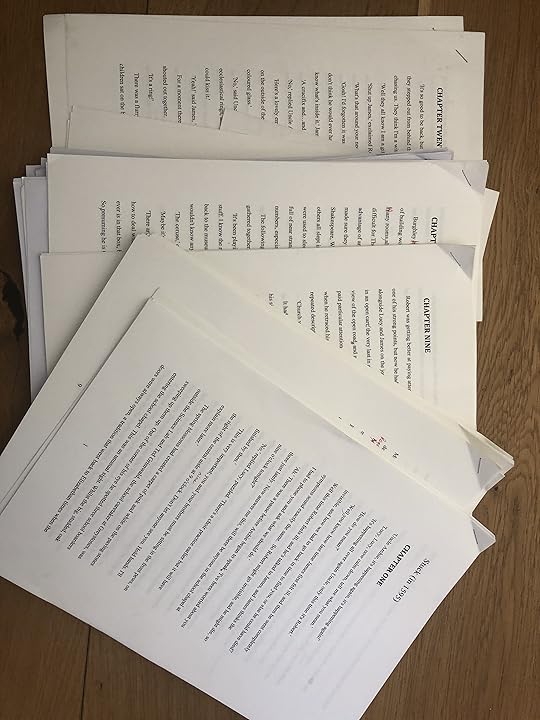
One way of looking at it would be I have been getting my priorities right, another would be putting it off!
However, I don't think I have an excuse. The kindle book has been published, and whilst I have been feeding my instagram account to help try and promote it, I think it will be better to ramp up the publicity when the whole package is ready. I don't recall politicians using that phrase 'ramp up' before the current Coronavirus pandemic. A positive spin on the sentiment 'I'm not doing enough now so I promise to do better!'
Anyway, back to the 'package' - I've been formatting the paperback version. I hope it's OK, but I can't preview what I have uploaded until the cover has also been uploaded. Elizabeth Newsham is hoping to be able to produce the illustration/pattern for the back of the book over the coming weekend. Rachel is hoping to continue work on the audio recording next week, which means we can get the audio book published.
Actually, as I write I have just realised that there is something I can do - my talented friend Chris de Verteuil has given me some music that he has composed and performed for the audio book. I could make a start adding that.
Great! I can put off doing the corrections on the next book after all!
June 5, 2020
A choice of schools
Do the three children in my book attend a private boarding school?
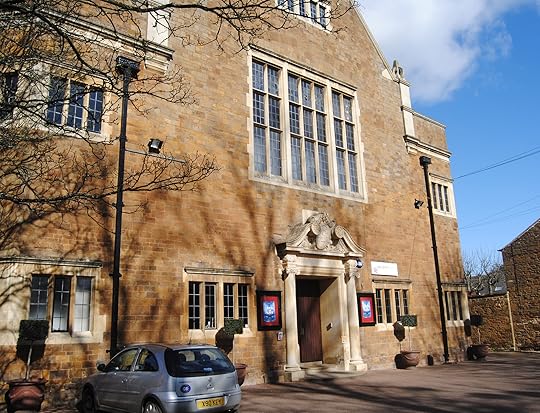
Uppingham School Theatre
In the UK the subject of private school education can be quite a divisive one, and I thought it might be useful to consider whether the children in Stuck (in time) are at private or state schools. I'm avoiding using the term 'Public Schools', because outside the UK a public school is often what we refer to as a state school
It's not really a plot spoiler because the book begins with Robert, James & Lucy sitting in the reception of their school waiting to spend their Easter vacation staying with their Uncle. Actually, nowhere in the book does it state it is a private boarding school, perhaps the reader will presume that it is, simply because it is a historic building. There are state boarding schools too of course in the UK
Boarding School? There are two factors here. Firstly I wanted to write the kind of book that I would have enjoyed reading as a child. Lots of the books that I read as a young boy were set in boarding schools, a strange fantasy land where boys referred to themselves by their second names - Jennings, Venables, etc. However, my books (I say books because the second one has been written - needs a little editing), are not essentially about school life and not, for the most part, set in school. Perhaps there is a little 'contrast & compare' of the education they receive with that of children in the 1940s in this first book but it is looking in general at present day education, not any comment on any perceived benefits of the private sector.
This brings me on to the second factor as to why a boarding school; it is because I wanted to create a situation where the children did not have the same degree of guidance or supervision from a parent or guardian as perhaps you or I did, so it would be easier for them to have adventures. I certainly wouldn't have let my own children go off gallivanting around the country on their own, never mind wandering off back into history!
I was very happy with the education that our children had at our local state school - Uppingham Community College. They all subsequently went on to university. I appreciate that we are fortunate to live where we live, and many people, especially those living in inner-city areas are faced with a dilemma when the nearest state schools do not perform well
So this is an issue that will be at the back of my mind for a while, and maybe addressed in a future book. There's no reason why it shouldn't be a state boarding school. The reason they are at a boarding school anyway is apparent in the first paragraph - they are orphans.
May 29, 2020
Updating my author page on Amazon
It's what you see when you scroll down on my Stuck (in time) book page on Amazon
It took several goes, because at first the site was showing a whole load of books about cameras and IT that have been written by another Dave Johnson. They removed them for me, but then my daughters spotted that when you scrolled down on a phone, it said this: ',I am a writer and photographer living near Seattle. In my spare time I play drums, scuba dive, and, along with the rest of my family, take car of my three cats, two dogs, and a slew of fish.' Well it sounds a great lifestyle, but it's not my life.
,Anyway, after several emails back and forth I have finally got it sorted.
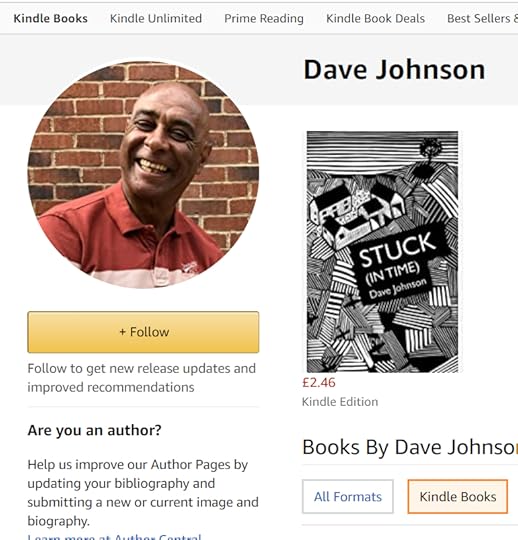
So to save you having to go there: this is what it says:
,It's time for a new direction. My first love was art, and at the age of 19 I found myself studying Printed Textiles at Liverpool School of Art, excited to be in the same building than John Lennon once went to, and next door to the school that Paul McCartney went to. I loved Liverpool, and still do, I love the city, the people and the football team! I met my wife at the college, and afterwards we both worked together as freelance textile designers, producing designs mostly for the USA market, using agents based in New York. I combined this with teaching at several colleges and universities, and after moving first to the North East, we settled in the tiny East Midlands county of Rutland.
,So working as a lecturer at Loughborough School of Art & Design (later Loughborough University) for over 20 years, and feeling proud to help so many talented students, I felt it was time for a change and I left. If I look back to my school years, at Changi Grammar School, (Singapore) the two other subjects I really liked were History and English. If I look at my life, past and present, one thing I have always enjoyed is reading stories to our three children, and now to our grandchildren. So that has pointed the way to my future.
,I wanted to create stories the kind of stories that I would have enjoyed as a child. Stories that adults would enjoy too, whether reading it to a child, or listening as an audio book, and the first of these my first novel, Stuck (in time). There are more in the series to come. I hope you enjoy it.
May 27, 2020
Insta what?
Now the book is published on Amazon the real work begins. I can find my book because I know what it is called, but can anyone else?
I've been learning about Instagram. I am fully aware that for some people this topic is like me saying, 'I've heard about this thing called a bicycle, it's got two wheels and…' and then you interrupt me and tell me that you have been riding one for years! Well of course I knew Instagram existed; my wife Sue still works as a designer and an artist, so I know that she has followers, and followers others, mostly artists and designers, whose work she likes. It didn't exist back in the days when I was a textile designer.

What I didn't know was that it is also a tool used by writers, there are lots of people on Instagram who love books, and whilst it is primarily a place to put images What I also didn't realise was the importance of hashtags. For the non cyclists amongst you, if you put a hashtag on your post, then it may well be seen by all the other people who have the same hashtag saved. The most popular hashtag is #love. However it's much better to use hashtags that are specific to the kinds of people you are interested in, and who might be interested in you - eg. #childrensbooks
I'll change metaphors now, from riding a bike to teaching grandma to suck eggs, and I will press on
If those people see your post, they might want to buy the book, and recommend it to their friends. So if they like your post they might click the heart 'like' , and if they really like your post they may decide to follow you, in which case, every time you post something they will receive a notification.
What am I doing? Well obviously you can't keep shouting 'I've written a book, I've written a book.' That's just SPAM, so to bring people to my home page I have a three pronged attack at the moment. First of all I put on some images directly related to the book such as the illustrations and some 1940s photos of my mum in the Land Army (land girls put in an appearance in the book). Secondly I've been posting photos entitled 'Things that sustain me' - you may have seen the photo of me with a cup of coffee standing next to our juke box. Thirdly, everyday I have been writing a rhyme (I hesitate to call them poems), I write the first verse onto a photo I have taken using Photoshop). Underneath my post I paste a bunch of different hashtags adding extra ones if appropriate, eg #poetry.
It's a strange thing really. As printed textile designers we were usually anonymous - nobody usually knows the name of the person who designed your shirt, but now it's all about me me me me me!
And for those in the know my instagram account is



